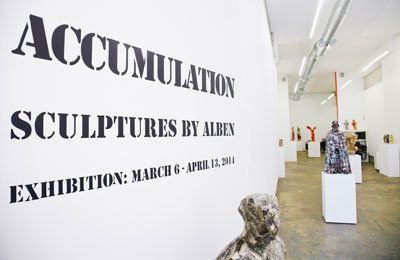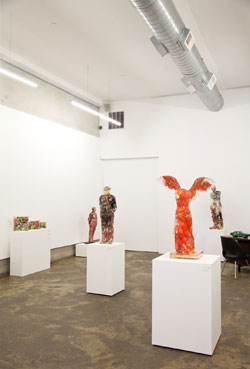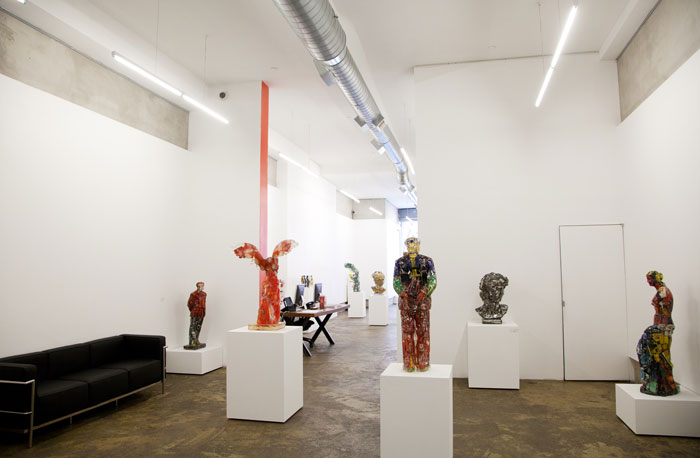by Caroline Hayward
April 17, 2014
 Visitors to French artist Alben’s latest solo show at Gallery Nine5 on Spring Street in New York City are greeted with a half-life-sized standing figure of former Chinese dictator Mao Zedong. The sculpture is rendered in clear resin and filled with sharp edged, broken pieces of blue and white pottery. To the left is a similarly scaled replica of the Venus de Milo. The statue’s graceful, stoic form is undercut by the crushed red Coca-Cola cans jammed inside. A statue of Darth Vader looms a few steps ahead, but becomes less menacing when the viewer realizes the dark tonality of the sculpture is achieved through the use of Coke Zero cans. These pieces are shiny and seductive, the outer forms acting as sleek packaging for the objects they enclose. About twenty multicolored sculptures are scattered around the gallery, each inviting the viewer for a closer look.
Visitors to French artist Alben’s latest solo show at Gallery Nine5 on Spring Street in New York City are greeted with a half-life-sized standing figure of former Chinese dictator Mao Zedong. The sculpture is rendered in clear resin and filled with sharp edged, broken pieces of blue and white pottery. To the left is a similarly scaled replica of the Venus de Milo. The statue’s graceful, stoic form is undercut by the crushed red Coca-Cola cans jammed inside. A statue of Darth Vader looms a few steps ahead, but becomes less menacing when the viewer realizes the dark tonality of the sculpture is achieved through the use of Coke Zero cans. These pieces are shiny and seductive, the outer forms acting as sleek packaging for the objects they enclose. About twenty multicolored sculptures are scattered around the gallery, each inviting the viewer for a closer look.
Accumulation is the artist’s second solo show at Gallery Nine5 and the first exclusively showcasing his sculptural pieces. This particular blending of iconic references appropriated from advertising, pop culture, and art history is the signature of Alben’s work. Each piece in the show is cast in resin and encapsulates a collection of culturally significant objects. Innocent Snow White Bonbons renders the Disney character sweet to the point of excess: We are granted access to peer straight into her soul, only to find it is made completely out of refined sugar and artificial coloring. Mickey Mouse and the Michelin Man, jolly characters gleaned from pop culture, are fused together creating Frankensteins of consumer culture filled with ceramic and plastic, common materials of mass production. The mash-ups of these characters with the objects inside impart new associations that are whimsical and humorous, as well as occasionally thought-provoking and politically motivated.
 Alben grew up in the 1970s in France where he became deeply immersed in street art culture. His paintings reflect this influence both in technique (he applies spray paint to the canvas with the aid of hand cut stencils) and style. His acute sensibility toward composition and his signature bright color palette have carried over from the paintings into his sculptures. Alben’s experience as a painter is most evident in a series titled Accumulation: Bon Bons I-V. The candies are not dumped into the resin haphazardly. They are carefully placed with intention to lead the viewer’s eye around the surface, creating interesting lines and spacial effects. These sculptures are a clear reference to one of the artist’s biggest influences, late Nouveau Realist painter and sculptor Arman. Arman, in fact, coined the term “Accumulation” in association with a group of works he created in the 1960s. This series of works was a reaction against Abstract Expressionism and correlated with ideas brought on by Pop Art and Minimalism. Arman’s Accumulations acknowledged contemporary sculpture’s inevitable collision with the commodified object by showcasing groups of nearly identical mass-produced goods arranged and suspended behind plexiglass and in resin. By removing commonplace objects such as high heels, alarm clocks, and musical instruments from their cultural context and intended purpose, Arman brought attention to their form and composition. While the objects retained their mass-produced qualities, Arman rendered them into abstraction through intense repetition.
Alben grew up in the 1970s in France where he became deeply immersed in street art culture. His paintings reflect this influence both in technique (he applies spray paint to the canvas with the aid of hand cut stencils) and style. His acute sensibility toward composition and his signature bright color palette have carried over from the paintings into his sculptures. Alben’s experience as a painter is most evident in a series titled Accumulation: Bon Bons I-V. The candies are not dumped into the resin haphazardly. They are carefully placed with intention to lead the viewer’s eye around the surface, creating interesting lines and spacial effects. These sculptures are a clear reference to one of the artist’s biggest influences, late Nouveau Realist painter and sculptor Arman. Arman, in fact, coined the term “Accumulation” in association with a group of works he created in the 1960s. This series of works was a reaction against Abstract Expressionism and correlated with ideas brought on by Pop Art and Minimalism. Arman’s Accumulations acknowledged contemporary sculpture’s inevitable collision with the commodified object by showcasing groups of nearly identical mass-produced goods arranged and suspended behind plexiglass and in resin. By removing commonplace objects such as high heels, alarm clocks, and musical instruments from their cultural context and intended purpose, Arman brought attention to their form and composition. While the objects retained their mass-produced qualities, Arman rendered them into abstraction through intense repetition.
In contrast, Alben’s take on the Accumulations is not an attempt to remove the cultural associations with the objects he uses. Moreover, his compositions encourage the viewer to find new meaning in the flashy packaging. Alben specifically chooses objects with rich social connotations. In the Accumulation: Bon Bons series, Alben is carefully selective of the candies and their placement within the mold. Instead of blurring into abstraction, the logos on the wrappers begin to stand out from one another, vying for the viewer’s attention. These cast-offs of American consumer culture become more than pieces of candy suspended in clear resin. They resonate with a much larger social commentary: Pop-Rocks begin to assert the artist’s relationship with Pop Art, PayDay bars comment on a wealth obsessed society, Tootsie Rolls and Juicy Fruit become symbolic of a sex-crazed media culture.
Alben further investigates the effect of ironic juxtapositioning in the replicas of classical sculpture filled with contemporary ready-mades. In one rendition, dozens of red McDonald’s fry sleeves are rendered timelessly beautiful, captured inside a figure of the Victoire de Samothrace, which is standing on a base littered on the inside with french fries. In Victoire de Samothrace TsingTao, another variation on the classical figure, the statue resembles a glittery emerald jewel from afar. Further investigation reveals that the figure’s rich color is a result of the encased cans of the popular Chinese beer TsingTao. These works are humorous on the surface, but also engage the viewer in a conversation about what types of objects modern society places value on. By elevating the detritus of consumerism to the status of highly revered symbols of humanity’s cultural achievements, Alben questions how future generations will interpret the products of our fast-food, high-fructose, sugar-saturated culture.

The sculptures that utilize the figure of Mao Zedong are some of the more provocative in the show. Mao is a charged cultural symbol and Alben uses his image to its full advantage. In a stroke of witty brilliance, Alben has unified Mao with figurines of villains from Star Wars in a series of small sculptures titled Mao Star Wars Series. In Mao Debout China (Grand), the communist leader’s body is thoroughly ridden with shards of painted blue and white pottery. Artisans in China have been making a living producing this style of pottery for thousands of years and it has historically been one of China’s most profitable exports. It is a longstanding symbol of the cultural history many Chinese citizens identify with. In Alben’s reiteration, Mao (modernization zealot and mastermind behind the Great Proletarian Cultural Revolution) holds pieces of one of his country’s most significant cultural symbols of tradition encased forever inside of him. This piece can be read simply as a satirical take on Mao’s failed cultural initiatives, but also more deeply interpreted as symbolic of modern China: a country struggling to evolve against the opposing forces of modernization and tradition.
In some cases, it feels as though the sculptures in this show are as easy to consume and discard as the sugary sweets inside them. Although the work is consistently clever and relatable, the strength lies in the aesthetic presentation and nostalgic associations more than the conceptual depth. It feels as if Alben has found a way to manufacture the essence of his complex, multilayered paintings into a group of neat, concise statements within each of the objects. The resin forms are pared down, much more succinct than his chaotic painting style. I found myself missing some of the ambiguity and confusion found in his paintings, which are obsessively layered with conflicting and varied imagery. The clear, glassy resin acts like seductive packaging that, once taken apart, tends to guide the viewer toward very specific issues without much wiggle room. After all, it is difficult to miss the connotations of consumer greed elicited from a pair of skulls filled with gold coins and poker chips, as seen in Crâne Gold and Crâne Vegas Chip. This early foray into the realm of sculpture holds much promise for Alben, but I do believe there is plenty of space for development. I look forward to seeing him push the limits of his technique and to seeing what he produces in the future.
Transcending Passages, Maisoon Al Saleh, March 16th - April 6th, 2021
Unbound Perspectives - SEPTEMBER 26-OCTOBER 17, 2020
East Villager Billy The Artist Climbs Atop Ai Wei Wei's Fence To Shine A Light On It
A Quick Note on Transplants: Greek Diaspora Artists
Teddy Thompson’s Ultimate Funeral Mix Tape
Moray Hillary, Pre-New Reflective by Heather Zises
SELFISH, Review by Heather Zises
Winter Realm Series by Noah Becker
Paul Rousso at Lanoue Fine Art
Airan Kang, The Luminous Poem at Bryce Wolkowitz Gallery
Damien Hoar De Galvan at Carroll and Sons
Antigone, 2015, directed by Ivo van Hove
Karen Jerzyk's unsettling Parallel World
CEK - Concrete Functional Sculptures
Alexis Dahan, ALARM! At Two Rams
Do Ho Suh, Drawings, at Lehmann Maupin
Winter Realm Series by Noah Becker
Nir Hod, Once Everything Was Much Better Even the Future
Exhibition Review: Mario Schifano 1960 – 67
Subverting the Realist Impulse in the Work of Shauna Born
Linder: Femme/Objet by Erik Martiny
Accumulation: Sculptural work by Alben at Gallery Nines
Justin Kimball at Carroll and Sons
Told & Foretold: The Cup in the Art of Samuel Bak, at Pucker Gallery
Collective Memory Manipulated: Sara Cwynar’s Flat Death
Art Paris Art Fair 2013 Review
Paris Street Art Musée de la Poste
Trellises by Katherine Tzu-Lan Mann
Topography of Destruction Kemper Museum
L'art en Guerre : France 1938-1947
The Louvre Relocates to Africa
A French Priest, Tears and Fire the Art of Jean-Michel Othoniel
